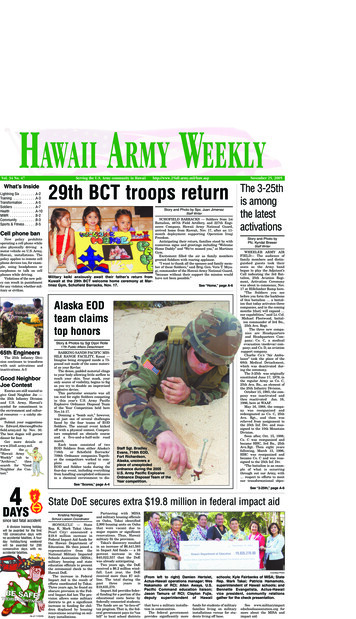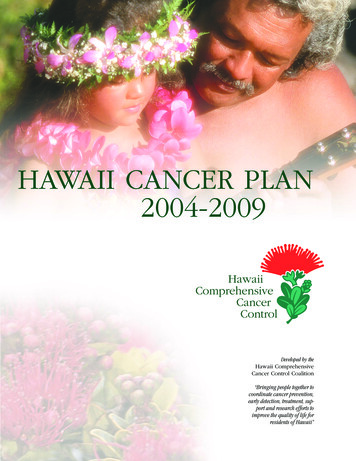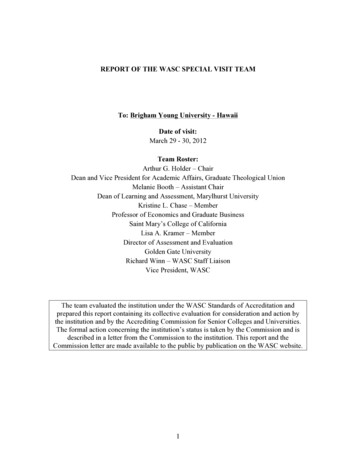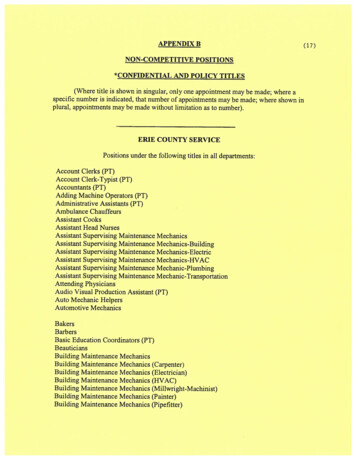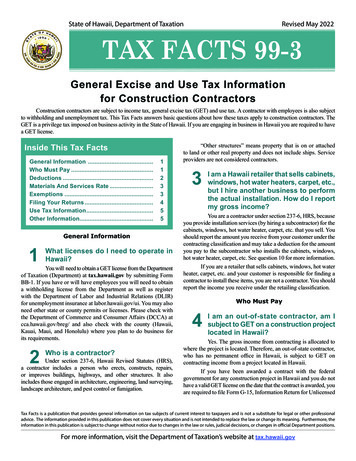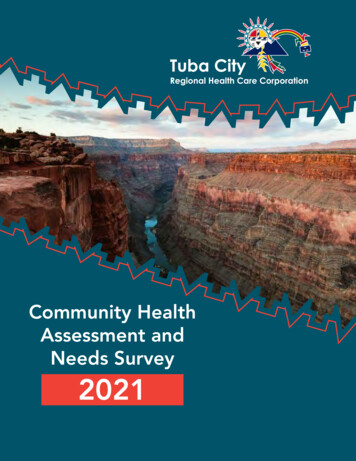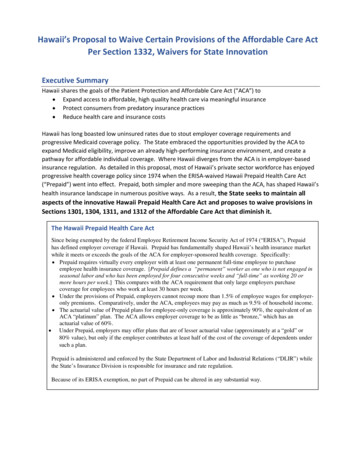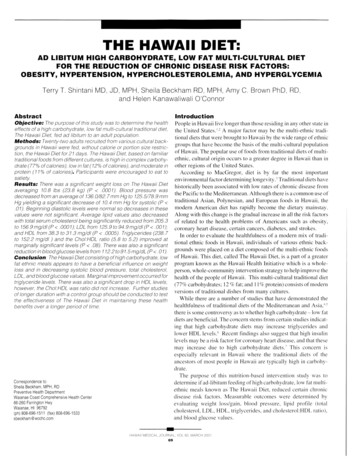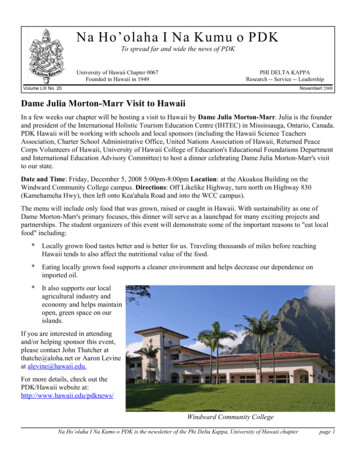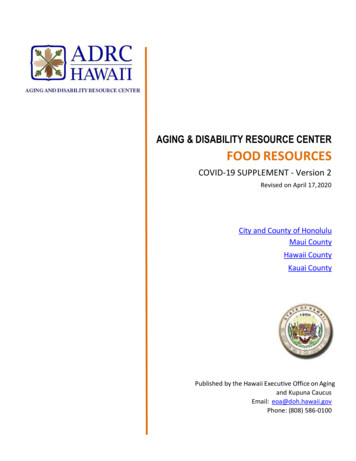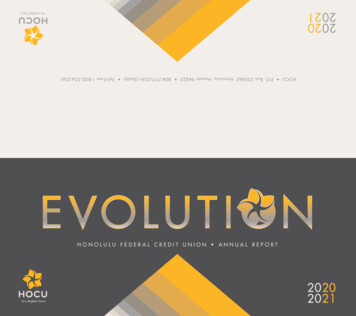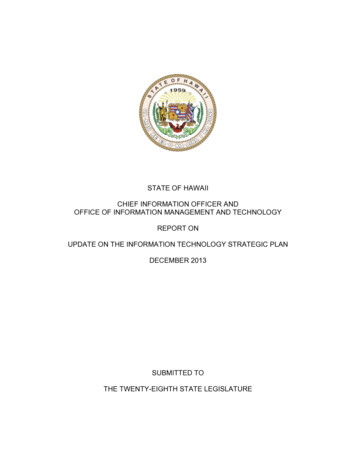
Transcription
STATE OF HAWAIICHIEF INFORMATION OFFICER ANDOFFICE OF INFORMATION MANAGEMENT AND TECHNOLOGYREPORT ONUPDATE ON THE INFORMATION TECHNOLOGY STRATEGIC PLANDECEMBER 2013SUBMITTED TOTHE TWENTY-EIGHTH STATE LEGISLATURE
STATE OF HAWAIICHIEF INFORMATION OFFICER ANDTHE OFFICE OF INFORMATION MANAGEMENT AND TECHNOLOGYUPDATE ON THE INFORMATION TECHNOLOGY STRATEGIC PLANDECEMBER 2013BACKGROUNDPursuant to Act 84, SLH 2011 (the Act), the Chief Information Officer (CIO) is requiredto submit a report to the legislature prior to the convening of the regular session of2013.BUSINESS TRANSFORMATION STRATEGY AND INFORMATION TECHNOLOGYSTRATEGIC PLANIn October 2012, the State CIO unveiled its plan to create an environment in Hawaii forinnovative industries to thrive and simultaneously apply technology to all sectors. The12-year roadmap for this major initiative is described in the Business and IT/IRMTransformation Plan. The Plan aims to transform the State’s current under-investedBusiness and IT/IRM environment and bring Hawaii into the 21st century.It includes: A Comprehensive Transformation Plano Plan: 20 Plans with 1,432 Pageso 7 phases over 12 yearso 3 Key Strategies and 10 Programso Affecting 18 agencies The Plan, will:o Reduce overall number of IT systemso Reallocate % of the IT workforce to better serve Departments’ missionso Streamline Business and IT operationso Increase IT service capabilities, reliability and securityo Reduce ongoing IT costso Improve Government TransparencyThe IT Transformation plan lays the groundwork for a future state that includes faster,better, and easier access to government information and services.2
OPPORTUNITIES FOR EXCELLENCEIn spite of various challenges, the State CIO has proactively moved to overcomeinstitutional limitations and have Hawaii become one of the best digital states in the U.S.within the next 10 years.With a focus on updated business applications, improved technology and infrastructure,and strong organizational culture— transformation is not only achievable, but underway.During 2012-2013, the State CIO has already undertaken several initiatives andpartnerships to transform the State’s IT environment, better serve citizens, and moveHawaii into the future.The key opportunity areas that the CIO identified to address the State’s primarychallenges were: Business Process and Business Environment: Providing more efficient andeffective applications to the citizens and departments of the State.Technology and Infrastructure: Embracing new and emerging technologies tobetter serve Hawaii.Organizational Culture and Governance: Creating enterprise-level strategicinvestments and providing open, transparent oversight on those investments.For each of the State’s three primary stakeholder groups, key opportunity areas wereidentified to overcome the State’s challenges.Prioritized OpportunitiesStakeholderStateDepartments andAgenciesState IT StaffImproved BusinessServicesProvide new andimproved IT servicesthat allowdepartments to focuson mission-criticalbusiness needs.UpdatedTechnologyInvest in updatedand efficienttechnologies thatwill savedepartments timeand money.Governance &OversightEnable moreefficient (less paperbased) processes;Using resourcesmore effectively &efficientlyOffer the necessaryresources, training,equipment, andfacilities to redevelop Hawaii’s ITWorkforce for the 21stCentury.Provide marketablejob skills andtraining onemergingtechnologies;provide IT staff withconsistent andrepeatableprocesses andtools.Provideopportunities forgrowth and learning.3
Residents ofHawaiiProvide residentswith timely,applicable, andsecure governmentservices.Allow access togovernmentinformation acrossmultiple devices;offer engaging andrelevantapplications tointeract with theState government.Ensure thatresident’s receivethe most from theirtax dollars.Invest in locallyowned businesseswhenever possible.THREE KEY STRATEGIES AND TOP 10 PROGRAMSIn an effort to overcome the State’s primary challenges, the State CIO has created threeguiding strategies to transform IT for the State and deliver increased IT value to allbranches of the government, the citizens of Hawaii, and third-party partners such aslocal businesses.These three CIO strategies guide 10 program initiatives that OIMT has undertakenduring 2012-2013—each program associated with one of the key guiding strategies.Within each of the programs are several projects that have either been completed or arecurrently in progress to achieve the program’s objective.4
MAJOR MILESTONES AND DELIVERABLESThe Business and IT/IRM Transformation Plan identified three key strategies to whichall program and projects would align. During FY13 the Major Milestones andDeliverables were completed under these key strategies:The Business and IT/IRM Transformation Plan identified three key strategies to whichall program and projects would align. During FY13 the following major milestones andDeliverables were completed under these key strategies:Strategy 1: Transform Business will re-engineer business processes and applicationsfor a new way of doing business in Hawaii (online).1. Enterprise Resource Planning (ERP System)a. Uniform Chart of Accounts — The State is in the process of preparing aRequest For Proposal (RFP) to solicit a vendor to assist with establishinga new Uniform Chart of Accounts.b. Interim Grants (iFAMS) —The interim Federal Award ManagementSystem (iFAMS) will provide an immediate solution to improve the State’sability to manage and consistently report on federal awards. The project isin the final stage of the procurement process.c. Interim Budget — Department of Budget and Finance, Department ofHuman Services, and OIMT have partnered to develop an Interim BudgetSolution. The project is temporarily on hold until the FY 2013supplemental budget period is completed.d. Interim Assets — This project requires the Department of Accounting andGeneral Services to coordinate an inventory of public buildings, facilities,and sites on public trust lands. Inventory information by December 1,2013. This project is currently in a planning stage.e. Enterprise Resource Planning (ERP) — The Request for Proposal, No.RFP-13-016-SW was released on September 16, 2013. The second roundof written questions from prospective offerors regarding the RFP and theOfferor's Library are currently being accepted.2. Tax System Modernizationa. The DoTAX, OIMT, and SPO are working collaboratively to expedite therelease of the TSM Program RFPb. Two Mobile Applications were completed in coordination with DoTAXc. A Tax Analytics Project was completed in coordination with DoTAX3. Health IT — The Health IT initiatives in OIMT incorporate aspects of technologyplanning and implementation across agencies including the Department ofHealth, Department of Human Services, Department of Commerce andConsumer Affairs, Governor's Office of Healthcare Transformation, and others,towards coordination of projects, information systems, and informationmanagement in these areas.5
a. OIMT Health IT has concluded all work in an official capacity coordinatingmulti-agency planning and implementation around the Hawaii HealthConnector. Recent efforts include the successful launch of the MedicaidKOLEA eligibility system and State Data Services Hub on October 1 (ledby DHS), the latter of which will serve as a future pathway to seamlessmodernization of information flows across state agencies. Continuingphases of the Hub are in progress, for communicating information to DHSfrom other agencies. The State CIO and DCIO Business TransformationOfficer (BTO) also helped the Hawaii Health Connector (HHC) get theHawaii Health Insurance Exchange (HHIX) fully up and running byOctober 15, 2013 after bringing up partial capability on October 1, 2013.The HHIX has been running stable after coming up on October 15, 2013compared to many other exchanges in the country. The State CIO,DCIO/BTO and Health IT Manager were also asked to help solve otherHHC problems with HHIX, to be successfully concluded on December 9,2013, with transfer of Integrated Program Management Office (IPMO)Functions to the HHC and the new interim Director. A full report of theproject has been drafted.b. Major projects in progress include all Health IT aspects of the Governor'sOffice for Healthcare Transformation's State Healthcare Innovation Plan,towards integrated components of a learning health system that movesinformation to providers, State programs, and public health in anexpeditious manner for appropriate, secure usage, or analysis. ThisHealthcare Transformation plan, under the auspices of the Federal CMSCCIIO State Innovation Model Planning Grant, is to be completed byJanuary 30, 2014, with implementation grant application and additionalefforts thereafter.c. One continuing project of significant importance is coordinating stateagencies (via the Hawaii Health IT Committee and other actions) for theplanning, building, and advancing the non-profit state-designated HawaiiHealth Information Exchange (HHIE). This comprises activities with theDepartment of Health's budgetary allocation for public health functions,Department of Human Services MedQuest program for alignment andfunding to build infrastructure for delivery of clinical information toMedicaid providers, and under the strategic leadership and direction of theGovernor's Healthcare Transformation Coordinator, who is the StateHealth IT Coordinator. The HHIE program, originally Federally funded byONC in alignment with the Electronic Health Record (EHR) meaningfuluse program, is ending in February 2014, at which point continuing privateand relevant State funding is anticipated during the building phase of theHHIE network, to enable robust sharing of clinical records across Hawaiilicensed healthcare providers.d. The Medicare and Hawaii MedQuest meaningful use programs arecontinuing in operations towards the national goal of connectingphysicians and clinics to EHR and regional HIE such as the Hawaii HIE,6
for information sharing. Of note, the Health IT program has completed theinitial planning cycle for information technology components of the AllPayer-Claims Database (APCD) with Healthcare Transformation. Thus farthis incorporates a program plan, a Request For Information (RFI)completed, and a Request For Proposals (RFP) to be issued in theJanuary-February timetable for the APCD.e. Other continuing efforts include coordination of telehealth planning amongagencies and stakeholders.4. Business Process Re-engineering (BPR) — The Business TransformationRepresentative (BTR) program is in the Business Transformation Office underthe Office of Information Management and Technology (OIMT). The purpose ofthe BPR program is to support Departments in Business Process Reengineeringefforts and innovation statewide. Each Department has designated a BusinessTransformation Representative (BTR) to work with OIMT to support this program.Business Case Documentation was submitted by the Departments to securefunding for BPR projects. The following projects are being supported by OIMT toassist the Departments in their transformation efforts:a. Department of Health, Contract GENie: The goal of this project is toreduce the overall time needed to process a contract from the date ofaward to the date of execution. Project Goal: 90% of all new contracts willbe executed within 60 days of contract award.b. Department of Human Services, DHS BESSED INVO DatabaseConsolidation: Integrate multiple data systems across various BESSEDoffices to result in a standard process and system to track SNAP fraudcases and investigations.c. Department of Health, Vital Records Ordering and Tracking System(VROTS): Reduce the amount of walk-in vital records and mail orderrequests by increasing online orders. This would increase customersatisfaction by providing order information and status tracking. Providingthis service will streamline issuance processes enabling more services tobe available online.d. Attorney General, Advice memo Automation: The goal of this project is tocreate an electronic database that will store advice memos currentlystored in paper files in the Department of the Attorney General,Land/Transportation Division. The project will encompass scanning allhard copy files into soft copy format, and to index the documents foreasier search/retrieval. This will allow for better search and indexingcapabilities making the files more accessible and useful to the staff.e. Department of Agriculture, Contract Management System (CMS): Thegoal is to provide an integrated information system to administer contractsstatewide.f. Department of Defense, File Conversion into Electronic Format: The goalof this project is to convert paper files into an electronic format. This will7
eliminate over 20 file cabinets and create to create space for a study hallfor the Youth Challenge Academy Cadets.g. Department of Agriculture, Quality Assurance Information ManagementSystem (QAIMS): The QAIMS will enable staff to better protectconsumers, businesses, and manufacturers from unfair practices, basedon a measurement process or subject to a standard of quality. The goal isto minimize losses and inaccuracies due to incorrect or fraudulentcommercial measuring equipment, processes, or substandard products.Also to provide services and enforce laws that help to improve the marketquality of agriculture commodities, promote fair trade and honest businesspractices.h. Department of Accounting and General Services, Public Works Division:Create a web-based system to allow construction design consultants toaccess plans and other documents of our current State facilities.i.Public Safety Division, Dashboard for Decision Making: Improveperformance of the organization by making better decisions using keytargets and indicators to measure performance.j.Department of Human Resources and Development, Online UnskilledLabor Registration Class System for Applicant Processing and Hiring:Expand efforts to track all state employment interests independent ofappointment type. This tool will provide Departments and agencies with astandard online tool to manage registration class applicants and providethe ability generate applicant lists to meet hiring objectives.Strategy 2: Modernize Technology will consolidate and modernize the infrastructureinto more secure and reliable backbone with common enterprise shared services for allDepartments.1. Enterprise Consolidated Infrastructure – These projects begin to consolidatethe State’s infrastructure, including data center management, to reduce theoverall number of IT systems, reduce ongoing costs, increase IT servicecapabilities, reliability and security, and streamline IT operations.a. The Government Private Cloud (GPC) virtualization systems have beensetup and the Cloud Operations Leadership Team (COLT) made up ofOIMT, ICSD, other department staff, are working to configure the cloudservices and launch operational capability for departments so they maybegin migrating their servers over to the new systems thereby offsettingcosts for hardware, software, and labor. Training will begin next quarterfor the cloud provisioning interface.2. Enterprise Shared Services – These projects will centrally provide services thatare common across departments (i.e. email, document management,collaboration, geographic information systems, etc.), which will result in reduced8
overall IT maintenance costs, increase IT services and capabilities, andstreamline IT operations.a. The Office365 pilot is underway and a handful of accounts have beenmigrated to the cloud. The hosted voice pilot (Voice-over-IP) has beenlaunched and the cabling upgraded to CAT6 in the Keoni Ana building tosupport the project. The State Archives Division (DAGS) has prepared anRFP for document imaging pilot and paper document conversion to digitalformat. The procurement is in progress for a Geographic InformationSystem (GIS) enterprise license, which would provide unlimited licensingof GIS software statewide. OIMT is beginning to communicate withdepartments and promoting consolidated purchasing of equipment andsoftware as well as setting up an internal services chargebackmechanism.3. Enterprise Security and Privacy – These projects will improve the State’scyber-security posture to ensure protection of the state’s valuable informationand data assets.a. OIMT and ICSD have just completed setup of the Security OperationsCenter (SOC) in the Keoni Ana building. The team is now configuring thenetworking and security monitoring software that will run in the SOC.4. Hawaii Broadband Initiative (HBI) — Under the Hawaii Broadband Initiative(HBI) OIMT in coordination with DBEDT and the DOD is pursuing a plan to landnew transpacific fiber optic cables in Hawaii. The design includes constructingsecure cable landing sites and deploying fiber optic transport that connects newtranspacific cables with the existing transpacific cable infrastructure and landingstations. The state is also increasing the reliability and security of inter-islandand backbone networks by providing 10Gbps bandwidth and a network reliabilityof 99.9%. The new networks are secure, resilient, redundant, and follow diversepathways to mitigate any interruption of service.Strategy 3: Improve Management and Oversight through Transparency andAccountability is the overarching strategy that will define tools, portfolio, policies,process, architecture, organization, and “trust but verify” performance throughdashboards and periodic management reviews.1. Governancea. Enterprise Architecture – These projects will define the capital planningand investment control for the IT environment.i. Secured consultant support to develop enterprise architecture.ii. The processes for approval of technology projects and purchaseshave been documented and are being vetted through theEnterprise Architecture working groups.9
b. Portfolio Management – These projects will provide the support andservices required to manage the IT portfolio across all departments.i. Secured consultant support to design and develop portfoliomanagement system.ii. The Program Management Information System (PMIS) “Alpha”version of the on-line web system has been created and will launchnext quarter.2. Open Governmenta. Hawaii StateStat Dashboard – Dashboard for executive branchdepartments to monitor and measure progress against mission goals andobjectivesi. Provided training to all agenciesii. Working with agencies to define their goals and metricsiii. Established a Data Council to define the data strategy forHawaii that includes the creation of a statewide data inventory,standardization of data and descriptions of data, implement theOpen Data Act 263.ORGANIZATIONWith functional oversight of the Information Communications Services Division, OIMT isnow working towards reorganization and integration of the two organizations. OIMT isworking with the Governor’s office and the Departments of Accounting and GeneralServices (DAGS), Human Resources Development (DHRD), and Budget and Finance(B&F) to formalize the reorganization and draft suggested legislation, if necessary.a. OIMT is drafting a new organizational chart in the DAGS format that alignsthe administrative reporting of OIMT and ICSD incorporating all exempt andcivil service positions. The new draft organizational chart is being reviewedinternally with ICSD management and will then be presented to DAGS HRand ASO. Following the consent of DAGS the organizational chart will bedistributed to DHRD. It is anticipated that a union consultation will occur inthe next quarter.b. OIMT is reviewing civil service job classifications for IT positions in ICSD andconsidering the “broad-banding” of salary ranges for the classes.c. Change Management &Leadership Training and Facilitation — During the firstphase from June 2013 to December 2013, the following accomplishments onthis program were made: Implemented Executive coaching with CIO & Executive Leadership Developed a Strategic-Operation Plan (StratOp) with OIMT & ICSDleadership team (18); cascaded Process to 35 ICSD Staff & 14 CIO’s Started to empower ICSD Leadership with Action Initiative Plans Began to unify the leadership of OIMT & ICSD through common vision10
Redeveloped and refined new vision, mission statements, & valuesDeveloped a new office name prototype OCIODeveloped a new service delivery modelWorked to attenuate any inimicality/resistance between OIMT/ICSDBegun the building of an internal communications planProvided Birkman assessments and feedback to 18 OIMT and 35ICSD staff, and 14 CIO council membersDelivered Birkman team building training to all OIMT staff, 35 ICSDstaff and 14 CIO’s; Delivered Appreciative Inquiry TrainingDeveloped a healthy readiness for change with ICSD leadership usingCycle or Renewal Change Management processDeveloping quick WINs with CIO’sEngaged ICSD in healthy talk story sessions and engaged them in theDigital Summit (open door policy)MAJOR EVENT – HAWAII DIGITAL GOVERNMENT SUMMIT 2013The State of Hawaii successfully completed the annual Hawaii Digital GovernmentSummit 2013 held on November 21, 2013. This event set a record with over 900people in attendance (750 planned) from State, Local and Federal Government,Academia and Industry within the State of Hawaii. The Event had 20 sessions dividedinto three tracks coinciding with the three key strategies, the three key organizationalleaders under the State CIO, and Top 10 Enterprise programs. The event was free toGovernment attendees, arranged by Center for Digital Government, who organizes andholds these events throughout the countries with State Government, through theirproven business model. The theme for the event was “Transforming Government at theSpeed of Life”, coined by OIMT/ICSD Staff. The sessions were informative with positiveenergy for the transformation of the State of Hawaii and a greater than 4/5 rating byattendees. The overall agenda, briefings, video presentations are posted -government-summit/AWARDSThe State of Hawaii recognized and applauded the excellent efforts of employeesacross many departments and from different functions, as well as other stakeholder thathave helped move the state along its transformation journey. 58 Award categories werepresented in three categories of recognition: Business Transformation, TechnologyModernization, and Government Transparency and Accountability. Within eachcategory, recipients across the following themes were recognized: Citizen Facing,Industry, State, and National. Additionally, three special CIO Awards were presented.The State CIO received the prestigious Fed100 Award for the Business and IT/IRMTransformation Plan – the only state to receive such recognition! OIMT also oversawthe Hawaii Portal winning three national awards, while four Departments won nationalawards for business and technology transformation in 2013. Please refer to URLs:http://oimt.hawaii.gov and .FINAL .pdf11
FUNDING – CURRENT AND PLANNEDThe following details the expenditures for each project using these funds during bothFY12-13 and FY13-14. Assessment, phasing, alignment, and planning analysis havebeen completed for the OIMT project portfolio of procurements, which were targeted forcompletion by the close FY13. All general funds were expended with no dollars lapsing.Below is a breakdown of OIMT funded and managed projects noting their area of focus,estimated cost, and number of sub-programs1.1Amounts may be adjusted as procurements are developed and/or completed and additional projectsynergies are realized.12
b. Interim Grants (iFAMS) —The interim Federal Award Management System (iFAMS) will provide an immediate solution to improve the State's ability to manage and consistently report on federal awards. The project is in the final stage of the procurement process. c. Interim Budget — Department of Budget and Finance, Department of
